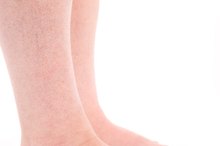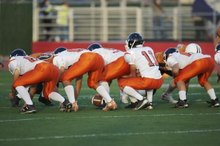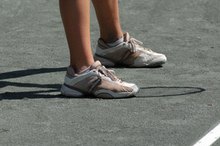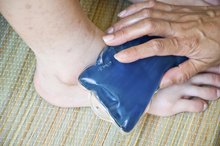What Causes Burning Knee Pain After Exercise?
Knee pain is one of the most common reasons for a doctor's visit, according to the American Academy of Orthopaedic Surgeons. Many individuals experience a burning knee pain as the result of exercise. This burning knee pain can be attributed to a number of conditions including bursitis, patello-femoral syndrome, osteoarthritis and tendinitis. Always consult your doctor if you experience a burning knee pain after exercise.
Bursitis
Knee bursitis is the inflammation of the small fluid-filled sack known as your bursa. Your bursa is located near your knee joint and aids in reducing friction and tension in the muscles, bones and tendons surrounding your knee joint. Symptoms of bursitis include burning, pain, tenderness, swelling and being warm to the touch. Bursitis symptoms will continue to worsen as you exercise and after repetitive use of your knee. Knee bursitis is diagnosed through a physical exam and imaging tests to help rule out any other knee conditions. Your doctor may also collect a sample of fluid from your knee for testing. Injections, physical therapy, aspiration or antibiotics are the common treatments for knee bursitis.
- Knee bursitis is the inflammation of the small fluid-filled sack known as your bursa.
- Your bursa is located near your knee joint and aids in reducing friction and tension in the muscles, bones and tendons surrounding your knee joint.
Patello-Femoral Syndrome
Unexplained Shooting Pain in My Shins
Learn More
Patello-femoral syndrome is another condition associated with knee burning, especially following exercise. Patello-femoral syndrome occurs when the patella pushes up on the sides of your knees. This condition is made worse by increased physical activity and is often the result of muscle tightness or weakness, poor conditioning or bio-mechanical abnormalities -- including overpronation or knock knees. Pain and burning is generally felt in the front portion of your knee but may also occur on the inside or outside portions of your knee. A diagnosis is made through a physical exam and imaging tests. Treatment involves rest, icing and anti-inflammatory medications. You can also tape or use a knee brace to help correct abnormal knee positioning. Stretching your legs is also beneficial in healing and preventing patello-femoral syndrome.
- Patello-femoral syndrome is another condition associated with knee burning, especially following exercise.
- This condition is made worse by increased physical activity and is often the result of muscle tightness or weakness, poor conditioning or bio-mechanical abnormalities -- including overpronation or knock knees.
Osteoarthritis
Osteoarthritis is the gradual deterioration of the cartilage inside your knee joint. As the condition progresses, your cartilage can become completely worn away, leaving bone rubbing on bone. This condition generally affects middle-aged and older adults. Osteoarthritis can lead to pain and burning in your knee joint while you're engaging in physical activity or doing daily tasks. This condition is diagnosed with a physical exam and x-ray ordered by your doctor. Treatment for osteoarthritis of the knee can include anti-inflammatory medications, activity modification, knee bracing, physical therapy or, as a last resort, surgery.
- Osteoarthritis is the gradual deterioration of the cartilage inside your knee joint.
- As the condition progresses, your cartilage can become completely worn away, leaving bone rubbing on bone.
Tendinitis
How to Tell if You Have a Bruised MCL
Learn More
Patellar -- or knee -- tendinitis is an injury to your knee that affects the tendons that connect your knee to your shinbone. Tendinitis is common in athletes whose sports require frequent running and jumping. Pain and burning are likely to occur during exercise and sports. While resting, your symptoms may subside completely or you may be left with a dull ache. Your doctor will complete a physical exam and order imaging tests to rule out any other knee conditions prior to making a diagnosis of patellar tendinitis. Tendinitis is most commonly treated with rest as well as stretching and strengthening the tendons in your knee. Corticosteroid injections, a knee brace or topical medication may also be beneficial in treating this condition.
- Patellar -- or knee -- tendinitis is an injury to your knee that affects the tendons that connect your knee to your shinbone.
- Tendinitis is most commonly treated with rest as well as stretching and strengthening the tendons in your knee.
Related Articles
References
- American Academy of Orthopaedic Surgeons: Knee Tendon Bursitis
- American Academy of Orthopaedic Surgeons: Arthritis of the Knee
- UC San Diego Health System: Patellar Tendinitis
- Lespasio MJ, Piuzzi NS, Husni ME, Muschler GF, Guarino A, Mont MA. Knee Osteoarthritis: A Primer. Perm J. 2017;21:16-183. doi:10.7812/TPP/16-183
- Kiapour AM, Murray MM. Basic science of anterior cruciate ligament injury and repair. Bone Joint Res. 2014;3(2):20-31. doi:10.1302/2046-3758.32.2000241
- Doral MN, Bilge O, Huri G, Turhan E, Verdonk R. Modern treatment of meniscal tears. EFORT Open Rev. 2018;3(5):260-268. doi:10.1302/2058-5241.3.170067
- Reinking MF. CURRENT CONCEPTS IN THE TREATMENT OF PATELLAR TENDINOPATHY. Int J Sports Phys Ther. 2016;11(6):854-866.
- Petersen W, Rembitzki I, Liebau C. Patellofemoral pain in athletes. Open Access J Sports Med. 2017;8:143-154. doi:10.2147/OAJSM.S133406
- Frush TJ, Noyes FR. Baker's Cyst: Diagnostic and Surgical Considerations. Sports Health. 2015;7(4):359-65. doi:10.1177/1941738113520130
- Huang YC, Yeh WL. Endoscopic treatment of prepatellar bursitis. Int Orthop. 2011;35(3):355-8. doi:10.1007/s00264-010-1033-5
- Beals C, Flanigan D. A Review of Treatments for Iliotibial Band Syndrome in the Athletic Population. J Sports Med (Hindawi Publ Corp). 2013;2013:367169. doi:10.1155/2013/367169
- Tsai CH, Hsu CJ, Hung CH, Hsu HC. Primary traumatic patellar dislocation. J Orthop Surg Res. 2012;7:21. doi:10.1186/1749-799X-7-21
- Ragab G, Elshahaly M, Bardin T. Gout: An old disease in new perspective - A review. J Adv Res. 2017;8(5):495-511. doi:10.1016/j.jare.2017.04.008
- Lee PYF, Nixion A, Chandratreya A, Murray JM. Synovial Plica Syndrome of the Knee: A Commonly Overlooked Cause of Anterior Knee Pain. Surg J (N Y). 2017;3(1):e9-e16. doi:10.1055/s-0037-1598047
- Vaishya R, Azizi AT, Agarwal AK, Vijay V. Apophysitis of the Tibial Tuberosity (Osgood-Schlatter Disease): A Review. Cureus. 2016;8(9):e780. doi:10.7759/cureus.780
- Zanon G, Di vico G, Marullo M. Osteochondritis dissecans of the knee. Joints. 2014;2(1):29-36.
- Hindle P, Davidson E, Biant LC. Septic arthritis of the knee: the use and effect of antibiotics prior to diagnostic aspiration. Ann R Coll Surg Engl. 2012;94(5):351-5. doi:10.1308/003588412X13171221591015
- Gwinner C, Märdian S, Schwabe P, Schaser KD, Krapohl BD, Jung TM. Current concepts review: Fractures of the patella. GMS Interdiscip Plast Reconstr Surg DGPW. 2016;5:Doc01. doi:10.3205/iprs000080
- Voskuil R, Evenski AJ, Montgomery C, Emory CL. Malignant Bone Tumors of the Knee: How to Identify and Treat. J Knee Surg. 2019;32(4):305-314. doi:10.1055/s-0038-1675828
- Gupte C, St mart JP. The acute swollen knee: diagnosis and management. J R Soc Med. 2013;106(7):259-68. doi:10.1177/0141076813482831
- American Academy of Orthopedic Surgeons. Unstable Kneecap.
- Bhatia D, Bejarano T, Novo M. Current interventions in the management of knee osteoarthritis. Journal of Pharmacy & Bioallied Sciences 2013 Jan-Mar;5(1):30-38. doi:%2010.4103/0975-7406.106561
- Bronstein RD, Schaffer JC. Physical Examination of the Knee: Meniscus, Cartilage, and Patellofemoral Conditions. J Am Acad Orthop Surg. 2017 May;25(5):365-374.
- Browne K, Kurtz CA. How to perform a comprehensive examination of the knee. JAAPA. 2009 Jun;22(6):20-25.
- Hergenroeder AC, Harvey BS. (2017). Osteochondritis dissecans (OCD): Clinical manifestations and diagnosis. Bachur RG, ed. UpToDate. Waltham, MA: UpToDate Inc.
Writer Bio
Michelle Zehr started writing professionally in 2009. She has written on health, fitness, fashion, interior design, home decorating,sports and finance for several websites. Zehr possesses a Bachelor of Arts in communication from the University of Pittsburgh, a Master of Arts in professional writing from Chatham University and a graduate certificate in health promotion from California University of Pennsylvania.








